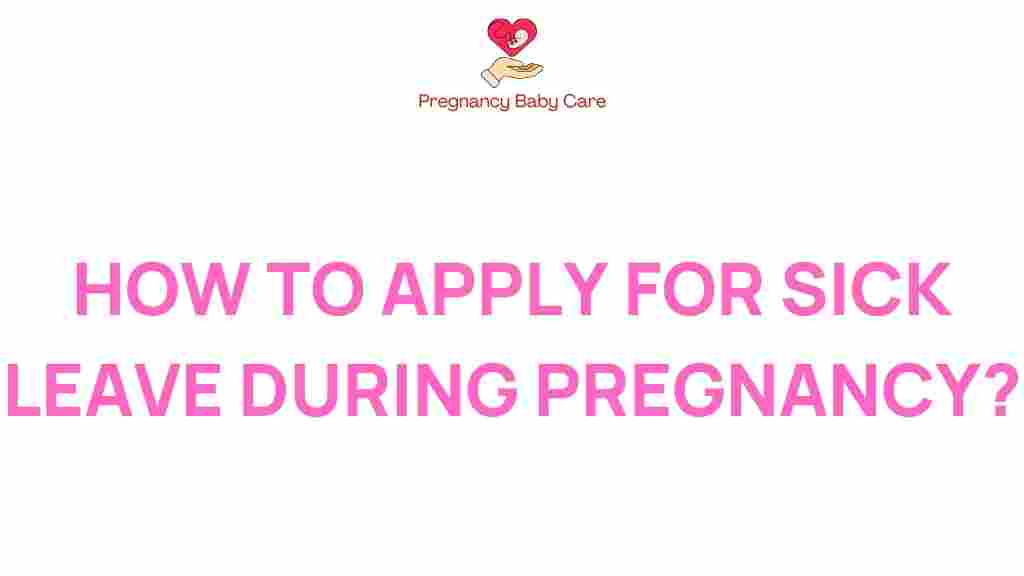Pregnancy is a transformative journey that comes with a range of experiences, both beautiful and challenging. For expecting mothers, understanding their rights and options regarding sick leave is crucial for ensuring health and wellbeing during this pivotal time. This article provides essential tips on how to navigate sick leave during pregnancy, focusing on maternity rights, workplace policies, and the support available for expecting mothers.
Understanding Sick Leave and Your Rights
Sick leave is a vital component of employment that allows employees to take time off work due to health issues without financial penalty. For pregnant women, sick leave can often become an essential concern as they navigate the physical and emotional demands of pregnancy. Here are some key points to consider:
- Know Your Rights: Familiarize yourself with your country’s maternity rights and sick leave policies. In many places, laws protect pregnant employees from discrimination and ensure they have access to necessary benefits.
- Company Policies: Review your workplace’s sick leave policy. Employers may have specific guidelines on how to report sick leave and what documentation is required.
- Communication is Key: Keep an open line of communication with your employer regarding your health and any necessary time off. This can help foster understanding and support.
When to Take Sick Leave During Pregnancy
Every pregnancy is unique, and the decision to take sick leave can depend on various factors. Here are some common scenarios when expecting mothers might consider taking sick leave:
- Severe Morning Sickness: Many women experience debilitating nausea and vomiting, especially in the first trimester.
- Health Complications: Conditions such as gestational diabetes, high blood pressure, or other medical issues may require time off for treatment and rest.
- Emotional Wellbeing: Pregnancy can be an emotional rollercoaster. If stress, anxiety, or depression become overwhelming, taking time off may be necessary.
- Regular Check-ups: Frequent doctor visits for prenatal care might also necessitate taking sick leave.
Steps to Take When Requesting Sick Leave
Requesting sick leave can feel daunting, but following a clear process can make it easier. Here’s a step-by-step guide:
1. Review Your Company’s Sick Leave Policy
Before making your request, ensure you understand your employer’s policies on sick leave. This includes:
- The amount of sick leave available to you.
- Any required documentation, such as a doctor’s note.
- The process for notifying your supervisor.
2. Notify Your Supervisor
Once you’ve determined your need for sick leave, inform your supervisor as soon as possible. Whether you choose to do this via email or in person, be clear and concise. Include:
- Your expected duration of leave.
- The reason for your leave, if comfortable sharing.
- Any arrangements you can make regarding your workload.
3. Provide Documentation
If your workplace requires a doctor’s note or other documentation, make sure you obtain this during your next appointment and submit it promptly.
4. Stay in Communication
Maintain contact with your employer during your sick leave. This can help keep them informed of your progress and any changes in your situation.
Benefits of Sick Leave During Pregnancy
Taking sick leave when necessary is not just a right; it is a critical support mechanism for expecting mothers. Here are some benefits:
- Improved Health: Allowing yourself time to recover can lead to better health outcomes for both mother and baby.
- Reduced Stress: Taking time off can alleviate the pressure of balancing work and health, leading to improved emotional wellbeing.
- Increased Productivity: Resting during difficult times can lead to increased productivity when you return to work.
Support for Expecting Mothers
It’s essential to seek support during pregnancy, especially when navigating sick leave. Consider the following resources:
- Human Resources: Your HR department can provide information on your rights and available benefits.
- Medical Professionals: Your doctor can offer guidance on your health and assist with necessary documentation.
- Support Groups: Connecting with other expecting mothers can provide emotional support and practical advice.
Workplace Accommodations
In addition to sick leave, some expecting mothers may require workplace accommodations. Discussing these with your employer can help create a supportive work environment. Possible accommodations include:
- Flexible work hours to attend medical appointments.
- Remote work options if your job allows it.
- Reduced workload during particularly challenging times.
Troubleshooting Common Issues
While navigating sick leave, you may encounter challenges. Here are some common issues and how to address them:
1. Denial of Sick Leave
If your request for sick leave is denied, review your company’s policy and understand your rights. If you believe the denial is unjust, consider:
- Requesting a meeting with HR for clarification.
- Gathering necessary documentation to support your request.
2. Lack of Support from Management
If you feel unsupported, document your communications and seek advice from HR or a trusted mentor within the company.
3. Conflicts with Coworkers
Taking sick leave may lead to tension with coworkers who may feel burdened by your absence. Address this by:
- Communicating openly with your team about your situation.
- Offering to assist in transitions before your leave.
Conclusion: Prioritizing Your Health and Wellbeing
Navigating sick leave during pregnancy is essential for ensuring the health and wellbeing of both mother and child. By understanding your maternity rights, communicating effectively with your employer, and seeking necessary support, you can create a positive experience during this significant time.
Remember, taking care of your health is a priority. Don’t hesitate to leverage sick leave benefits to ensure you have the best pregnancy experience possible. For more information on maternity rights and support, you can visit this resource.
For further reading on pregnancy and workplace rights, check out this article.
This article is in the category Pregnancy and created by PregnancyBabyCare Team
